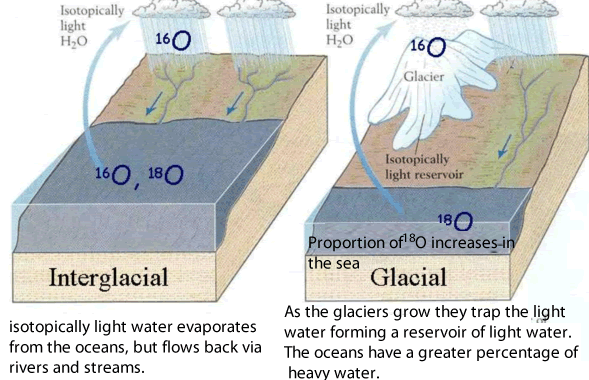Vostok ice core
The 800 year lag.
The Vostok core was drilled in East Antarctica, at the Soviet station Vostok to a depth 2083 m. Air samples trapped in the ice, have been analyzed with respect to isotopic content in 2H, dust, and methane and carbon dioxide trapped in air bubbles.

Analysing the ice core we can see past climate change, where periods of ice ages are separated by brief warm periods called interglacials. This pattern is due to gradual, regular changes in the earth's orbit and axis. The dominant influence on climate is the 100,000 year eccentricity cycle as the Earth's orbit changes from a more circular to a more elliptical orbit as shown on the right.
The eccentricity cycle causes changes in the intensity of incoming sunlight. We see an interrelationship between temperature and CO2., in that as temperature rises so does the level of CO2 in the atmosphere. However, atmospheric increases in CO2 levels lag the warming by 800 to 1000 years.
How does warming cause a rise in atmospheric CO2? As the oceans warm, the solubility of CO2 in water falls. An increase in temperature causes the oceans to give up more CO2, pumping it into the atmosphere.
When there's more CO2 in the atmosphere, the earth absorbs more heat. Shortwave radiation from the sun passes straight through our atmosphere and is absorbed by the earth. The earth emits it as longwave (infrared) radiation which is partially absorbed by atmospheric CO2. This is the greenhouse effect.
CO2 warming explains how the relatively weak effect on temperature change of the eccentricity cycles can bring the planet out of an ice age. It begins at the high southern latitudes (eg - Antarctica) where warming waters release CO2. The CO2 enters the atmosphere, amplifying and spreading the warming effect to northern latitudes.

Explain the term positive feedback.
What might have been the trigger for the past global warming episodes?
Describe the positive feedback that was responsible for amplifying the global warming that was initiated periodically by factors such as the Earth's orbit.
How can scientists determine the temperature of the atmosphere thousands of years ago simply by looking at the trapped air in the ice core?
The isotopic composition of water, and in particular the concentration of the heavy isotope of oxygen, 18O, relative to 16O, as well as 2H (deuterium) relative to 1H, is indicative of the temperatures of the environment. During cold periods, the concentration of less volatile 2H (18O) in the ice is lower than during warm periods. Water needs energy to form vapour. The heavier the molecule the greater the energy it needs to form vapour. So in colder tempera ut res the proportion of heavy water in the atmosphere would be less than during warmer periods. By measuring the ratio of heavy water to light water an accurate measurement of the temperature of the atmosphere can be achieved.

Calcium carbonate is a chemical compound that forms the shells of aquatic creatures.
It is formed in water when dissolved carbon dioxide reacts with water to form carbonic acid. Carbonic acid yields carbonate ions which react with calcium ions in the water to form calcium carbonate according to the equations below.
H2O + CO2 => H2CO3
(carbonic acid)
Ca2+ + CO32- => CaCO3 (calcium carbonate)
How can isotopes be used to distinguish between freshwater and saltwater fossils?
